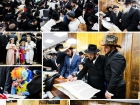Outsiders Article on Crown Heights Tour
On a recent summer morning, Rabbi Yoni Katz stood a few steps away from the Kingston train station, in the heart of Crown Heights, as he has been doing every day for the past two years. He was waiting for his guests to show up so he could usher them into a local library and begin his $69-per-head tour of the Hasidic community • Full Story
bedfordandbowery.com/By Jo Corona
On a recent summer morning, Rabbi Yoni Katz stood a few steps away from the Kingston train station, in the heart of Crown Heights, as he has been doing every day for the past two years. He was waiting for his guests to show up so he could usher them into a local library and begin his $69-per-head tour of the Hasidic community. As I exited the station and made my way down Kingston Street, I recognized his red beard and laid-back posture from an online profile and cheerfully walked up to him.
“Yoni? Hi!” I said, reaching out to shake hands. “Oh we don’t shake hands,” he said, catching me off guard. “Only men with men and women with women.”
Katz, 40, is a rabbi of the Lubavitch Hasidic movement and a tour guide who promises an insider’s look into a famously closed-off community. Given that most narratives about the Hasidim are told by people who left, Katz’s tour is a special phenomenon within the Orthodox Jewish groups of Brooklyn.
When we spoke on the phone, Katz had explained how the idea of the tour came to fruition: “Around seven years ago, Brooklyn, especially these very Hasidic neighborhoods of Crown Heights and Williamsburg, began to gentrify and people with beards started moving into these communities and have beards not for Hasidic purposes, so it started getting a little confusing,” he said, and joked, “Were they Hasidic or hipster?”
When tensions flared up over bike lanes crossing the Hasidic neighborhood in Williamsburg, Katz decided to do something. “I was sitting in a library one day,” he told me, “and I said, ‘I got it, let’s create an open forum where the Hasids and hipsters can get together and if the hipsters moving into the neighborhood have any questions about hasidic life they can ask.’”
The ensuing campaign, “Unite the Beards,” caught the attention of the media, which has written extensively about the animosity between the two groups, but very few showed up at the forum. Notwithstanding, “it showed something very interesting,” he said, “because the first guy I interviewed for a little video that I made asked me, ‘Why are you the first Hasidic Jews to speak to me on the street ever?’” The idea of bridging the divide grew stronger.
In our conversation, Katz said back then it wasn’t uncommon to find people offering tours of the neighborhood, but it wasn’t done on a grand scale. He picked it up two years ago, and would take curious guests to try pastries at a local matzah bakery, go into the ritual baths, chat with his wife Rivkah Katz in their home, see scribes restoring Torah scrolls or manufacturing little black leather boxes called Tefillin, and visit the synagogue and headquarters of the Chabad-Lubavitch Hasidic movement.
Aside from moving from point A to point B, most of the tour happens behind closed doors where, in Katz’s words, guests can see the “real, raw, authentic experience of Hasidic life as it unfolds in front of your eyes.”
The tipping point came in November of 2018, when Katz decided to promote the tour as an Airbnb experience. “It just exploded,” he recalled. “It got really popular. I was bringing in all types of groups of people. One day it could be 25 Mormons from a journalism class from Brigham Young University and the next day it could be a group from Dubai.”
The summer morning that B+B joined the tour, 10 people had signed up. They were mostly international travelers. There was a Brazilian woman, another from South Africa, a big family visiting from Denmark, and two Brooklyn natives, one of whom was originally from Saudi Arabia. We all clustered around tables in the Levi Yitzchok Library (a local religious library and nonprofit that receives the proceeds of the tours), sharing blank stares of curiosity and anticipation for what the next hours would be like. Having shepherded everybody in, Katz explained the no-physical-contact rule, saying that in the Hasidic community, even the slightest touch should be intimate. He said that the only bad question was “the one left unasked” and someone from the group was quick to inquire about the cloth tassels hanging out from underneath Hasidim’s shirts.
“That’s because we eat a lot of candy. It’s dental floss,” Katz said, cracking everybody up. No, not really. The fringes are called tzitzit, he explained. Each tassel has eight strings with five knots. Tallying up the numerology within the strings, one gets 613, the number of divine commandments that God gave the Jews: 248 positive, the rest negative or acts from which one should abstain. “When we see these it’s to remind us about following the commandments,” he said, touching his tzitzit. They’re kept under the shirt because of “Jewish mysticism,” though members of other Hasidic circles wear them on top.
The questions kept coming: why do you wear that thing on your head and what is it called? (A kippah; it’s to remind men that there is “something above our heads.”) How does Hasidic dating life work? (There’s a matchmaker in Crown Heights.) Why do kosher kitchens have three sinks, two ovens and two refrigerators? (Because meat and milk can’t be mixed, so meals with meat are prepared on one side and dairy meals on the other.)
What’s the deal with the wigs?
When this question was raised the group was wrapping up a visit to the mikvah, or ritual baths, in which women immerse themselves to “achieve ritual purity.” We could still see some traces of yesterday’s visitors in the used towels and slippers strewn across the floor and chairs of the spa-like rooms. Katz picked up a wig mannequin, a head with an abnormally long neck. “Wigs are made from human hair and their price can go from $500 to $5,000,” he said. Women cover their natural hair with wigs after they get married because in Judaism hair “has a lot of power,” he explained.
From there, Katz segwayed into Hasidic fashion. Women from the Lubavitcher movement tended to have longer wigs than the Hasids from Williamsburg, who went for a more modest look. He took his black fedora off and said men in Crown Heights used these while Williamsburg’s hasids wore the hard-to-miss round fur hats called shtreimel. It looks funny in 2019 New York City, Katz acknowledged, but the inspiration comes from how Eastern European and Russian aristocracy dressed a few centuries ago.
The differences between these highly ritualistic groups aren’t just cosmetic. In fact, there are over 200 branches of Hasidic communities in Brooklyn, according to Katz. Some are very large, like the Lubavitcher movement with its 20,000 Crown Heights residents, but most are so small Katz would have a hard time naming them himself. “I could name you 20 of them, I couldn’t name you 200,” he told me.
Each Hasidic branch is named after where they came from, originally from olden-age Russia. “Lubavitch was a tiny little village in Russia,” Katz said. “Actually, in Russian, Lubavitch means love.”
The Williamsburg men in fur hats and dark garb are from the Satmar community, originally from Hungary, “and they have a different philosophy,” Katz said. “Satmar is from a city in Hungary that is called Satu Mare which means Saint Mary, funnily enough. Where they live, that’s where the tensions with the hipsters and the bike lanes and all that happened.”
Katz’s openness to the outside world is likely influenced by the fact that he was born in Israel to a family of secular Jews. His parents became Orthodox only later in life. “My uncle is the head of a hospital in Pittsburgh,” he contextualized, throwing in a joke about tense family conversations during the holidays. But Katz’s personal story aside, the Crown Heights Hasids are less shut off from the exterior than other groups. While we were walking in the neighborhood, a Hasid sped by on his Harley Davidson and waved at Katz. The man who took a photo of the group vaped lazily as he waited for us to take our place at the front steps of the Chabad-Lubavitch headquarters/synagogue.
Not many of these tours exist. Out of the approximately 700 experiences Airbnb has in New York, the company found two other tours of Hasidic Brooklyn on their platform. One is given by an active member of the community, the other is offered by a woman who left what some would consider a sect. His is a very incipient endeavor in a community that even if it’s open to interacting with the outside world is still full of mysticism and strict adherence to biblical precepts.
According to Liz DeBold Fusco, Airbnb’s senior communications for the US East, the access Katz offers is “truly remarkable.” And visitors can sense that, as seen from the reviews: “Thank you so much, Yoni, for explaining you and your community’s philosophy and culture. Everybody was incredibly welcoming and open. It takes vulnerability to share yourself with the world, but you are opening windows of understanding,” commented a guest in July.
Our second-to-last stop was the synagogue, an unassuming mansion built in the early 20th century located at 770 Eastern Parkway. It was purchased in 1941 by the father-in-law of the Lubavitcher Rebbe, Rabbi Schneerson, more universally known as the Rebbe. “People always think the place is quiet. But it’s not,” Yoni warned the group as he led us into the synagogue, or what I would describe as the sidelines of the synagogue. Long wooden benches filled the corridor-looking room in which women sat reading in Hebrew or Yiddish, facing tinted windows overlooking the bustle of the main room, where men walked, talked, read or swayed in prayer. Many wore Tefillin black boxes like those we had seen up close a few moments before, just one of many details I am certain were lost to my untrained eye. Yoni said a new service began every 15 minutes and that he himself visited the synagogue three times a day.
While the room underneath us was teeming with activity, there were only a few women in the room Katz brought the tour group into. They seemed deep into their reading, but as the tour members ambled out of the room, one of them lifted her head and with a smile on her lips asked where we were from. Four hours and several Jewish pastries and snacks later, the tour ended with the group sitting around a dining table and listening to Ms. Katz talk about her relationship to God and her family.
1253
Join ChabadInfo's News Roundup and alerts for the HOTTEST Chabad news and updates!











































Very informative article I see the tour groups as they walk down Union street.
Very interesting glad for the information since I been living in Crown Heights many years moved here since I was 7 yrs. old & I am now 68 yrs. old never really thought much about my neighbors only as a religious group of people & back in my day we attended school together so I learned some things from a girl in my class for 4 years straight she informed me of many things.